Greetings! A major area of concern and sometimes confusion for us after weight loss surgery is how many grams of carbohydrates should we eat in a day. Have you been perplexed over the carbohydrate question? Today we take a look at carbs and the role they play our diet after weight loss surgery. It is popular in the health and nutrition fields to describe carbs as "good carbs" or "bad carbs". I prefer not to use those words because they assign a moral trait to food and food does not have moral traits. Food is food. When we remove moral assignment from the food we eat we can be smart, thoughtful, and rational with our choices. But if we assign morals to food and eat "bad carbs" then we must be bad. You know the self-blame cycle I'm talking about. Instead of good carbs and bad carbs I prefer to use more accurate terms: - Fruit and Vegetable Carbs or Complex Carbs
- Grain and Starch Carbs or Complex Carbs
- Processed Manufactured Carbs or Simple Carbs
I have them arranged in nutritional importance to us after undergoing weight loss surgery. Like other nutrients carbohydrates are measured in grams. A 2008 broad-canvas study of bariatric centers revealed that few bariatric surgeons or nutritionists give a specific daily quota for carbohydrate intake. Most default to the 113g RDA recommended by the National Academies' Institute of Medicine for people following a 1200 calorie a day diet. It takes roughly 8 to 10 cups of fruit and vegetables to equal 113g complex carbohydrates and I do not know any weight loss surgery patient who can consume that much volume. That is good news. While it is unlikely we can ever reach that daily intake by eating fruits and vegetables it is also unlikely we will ever over eat our carbohydrate allowance when we select high moisture, high fiber fruits and vegetables. A variety of fruits and vegetables promotes good health because they contain disease fighting vitamins and nutrients. Fruits and vegetables enjoyed with lean protein improve the overall eating experience for weight loss surgery patients because they are high in moisture. This is a relief when we are following the liquid restrictions and not drinking a beverage with meals. Today we look at 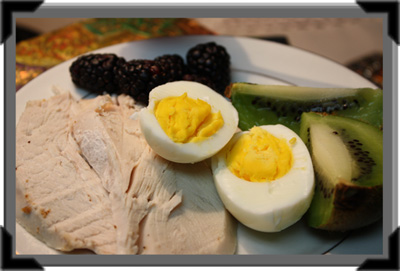 complex carbohydrates from fruits and vegetables. We have some great tips and recipes to include them in your diet for life-long weight management. Pictured here is a typical breakfast plate for me that included 2 ounces white meat roasted turkey, 1 hard-cooked egg, 6 blackberries and 1/2 large kiwifruit. After enjoying this meal I will not feel hungry or crave sweets for several hours. Nutritional Count: 182 Calories. (44% Protein, 32% Fat, 24% Carbohydrate); 20g Protein; 6g Fat; 11g Carbohydrate; 3g Dietary Fiber. 75% RDI Vitamin C, 25% RDI Niacin, 5% RDI Calcium.) I consider this plate a perfect breakfast and while I don't get it right every morning it is a goal I aim for because on days when I get this right I am powerful and in control. complex carbohydrates from fruits and vegetables. We have some great tips and recipes to include them in your diet for life-long weight management. Pictured here is a typical breakfast plate for me that included 2 ounces white meat roasted turkey, 1 hard-cooked egg, 6 blackberries and 1/2 large kiwifruit. After enjoying this meal I will not feel hungry or crave sweets for several hours. Nutritional Count: 182 Calories. (44% Protein, 32% Fat, 24% Carbohydrate); 20g Protein; 6g Fat; 11g Carbohydrate; 3g Dietary Fiber. 75% RDI Vitamin C, 25% RDI Niacin, 5% RDI Calcium.) I consider this plate a perfect breakfast and while I don't get it right every morning it is a goal I aim for because on days when I get this right I am powerful and in control. CHEERS!
Kaye Bailey
Copyright Consideration:
You are our valued reader. We respect your rights and privacy by never sharing your information with a third party. Please respect our creative rights by honoring copyright laws and prevent plagiarism.
Super Value: Save $21 LivingAfterWLS Bookworm Bundle Tools to Empower Your Success!
LivingAfterWLS Bookworm Bundle. Bundle includes: 5 Day Pouch Test Owner's Manual 2nd Edition (2012); Day 6: Beyond 5DPT (2009); Cooking with Kaye-Methods to Meals (2012). Over 250 recipes; 600 pages of effective empowerment supporting your healthy weight management. Suggested Publisher Price: $82.95 - Purchased separately $72.95 Bundle Price: $61.95 - (Save $21.00) SKU #LAWLS-BWB3 Quick Buy
Promo Code: FALL2013 takes $3 off your order!!
More Bargain Bundles at LivingAfterWLS General Store
Roasted Carrot Hummus I'm not a fan of regular hummus but I came across this recipe and made it using left-over oven roasted carrots. Used as a dip for vegetables or low-carb crackers this hummus is mellow and sweetly delicious. Try it with your next veggie tray and enjoy! Ingredients:1 cup oven roasted carrots 1 15-ounce can garbanzo beans (chickpeas), rinsed and drained 1/4 cup tahini (sesame seed paste) 2 tablespoons lemon juice 1 teaspoon bottled minced garlic 1/2 teaspoon ground cumin 1/4 teaspoon salt fresh parsley for garnish Directions: In a food processor bowl combine roasted carrots, garbanzo beans, tahini, lemon juice, garlic, cumin, and salt. Cover and process until smooth. Transfer to a serving bowl, garnish with parsley and serve with fresh vegetable dippers and low-carb crackers. Per tablespoon of hummus: 30 calories, 1g protein, 4g carbohydrate, 1g dietary fiber 1g fat, 62mg sodium.
Feed the Carb Monster Soup Mixes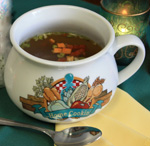 LivingAfterWLS is pleased to present our own Feed the Carb Monster Soup Mixes. Avoid carb cravings with our delicious and nutritious soup mixes. When used with the 5 Day Pouch Test or your regular post-weight loss surgery diet these soups are effective at curbing carb cravings without the calories or guilt. Just .88 cents per serving! Two great flavors: Hearty Vegetable and Tomato-Basil. SHOP NOW 
|
The Cost of Complex Carbs
Here's What You Get
| 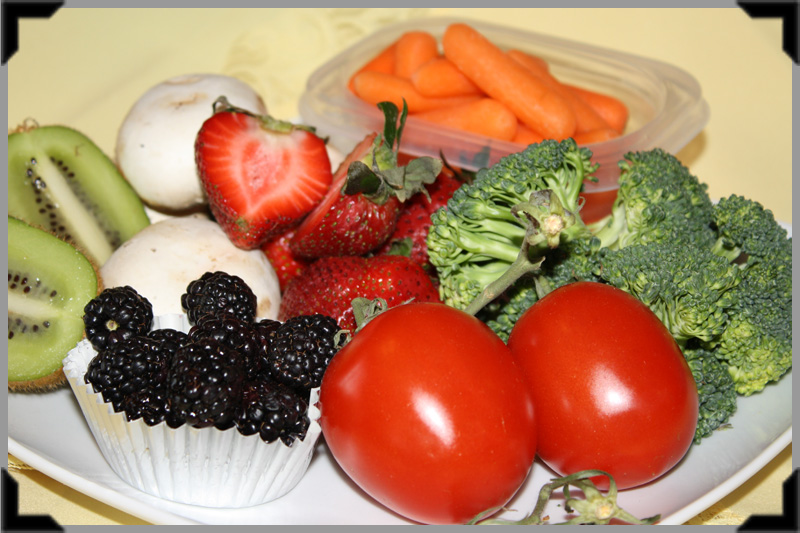
High fiber, high moisture complex carbohydrates included in the weight loss surgery diet provide healthy nutrients and vitamins and feelings of satiation without adversely affecting blood sugar or weight management.
This rainbow of fruits and vegetables arranged on a 9-inch square plate provides 63 grams of complex carbohydrates. The National Academy of Sciences' Recommended Dietary Allowance (RDA) for carbohydrate is at least 113 grams. Most bariatric centers follow this guideline when discussing carbohydrate intake with their patients.
Serving: 2 Roma Tomatoes, 1 cup broccoli, 1 cup baby carrots, 4 medium button mushrooms, 1 cup fresh ripe strawberries, 1/2 cup fresh black berries, 1 large kiwifruit. Volume: about 5 cups. Calories: 281 Carbohydrate: 63g Protein: 11g Fat: 1g Sodium: 215mg Cost*: $3.30 In comparison let's look at the top three processed simple carbohydrate snack foods that WLS patients report including in their diet: Fig Newtons: 2 Cookies Original Wheat Thins: 16 Crackers Pretzel Twists: 10 twists Total food volume: 1 cup Calories: 489 Carbohydrate: 92g Protein: 9g Fat: 10g Sodium: 1424mg Cost*: $2.19 As you can see, with only three foods and 1 cup of food volume we are 40 grams shy of our daily intake of carbohydrate (92g of 130g RDA). In addition these foods are frequently eaten as snacks and most of us know we can (and sometimes do) exceed the portion size without discomfort or even awareness. We would only need to add one Fig Newton, 8 Wheat Thins and 5 more pretzel twists to reach our daily carbohydrate intake. In addition, these simple carbohydrates fail to provide health promoting nutrients and vitamins and they may adversely affect blood sugar levels and weight management goals. My current practice of awareness is knowing that if the product is manufactured and labeled and I chose to eat that product I must count and record the carbohydrate values. You will notice when shopping that infrequently fresh fruits and vegetables are labeled for nutrition; they are not manufactured food. As a weight loss surgery patient with limited stomach space it is highly unlikely I will ever exceed the RDA of 130g per day when I chose fruit and vegetable carbs over processed simple carbs. The big bonus that comes from eating complex carbohydrates is not calculated in weight and measure. It is the freedom from self-loathing and moral judgment that so often accompanies our food choices. In all my work with weight loss surgery patients I have never heard someone say, "I just couldn't stop eating fresh vegetables, I was out of control, I am so angry at myself for doing that." Not once. The same cannot be said for our top three simple carbohydrate snacks that quickly become slider foods derailing our weight management. And finally, when we eat these healthy nutrient dense fruits and vegetables we stay full longer and report fewer cravings for snacky-carbs. Our overall health improves, skin and hair become radiant, we maintain steady energy levels, weight management is achieved and we don't feel badly about ourselves. *Cost is based on package items purchased at a big box warehouse store on April 1, 2011. Prices may vary by region and season. 5 Day Pouch Test Article Index Learn more about simple carbs and how they become slider foods and derail our weight management efforts. |
Enjoy Healthy Carbs in these
Taste Pleasing Side Dishes | 
Including fresh vegetables and berries in a meal of lean protein assures you get a variety of nutrients and fresh flavor without sacrificing your healthy living goals. Some weight loss surgery patients notice the stringy fiber of asparagus causes digestive discomfort. Look for tender young stalks to avoid the stringy fibers or use a vegetable peeler and remove the outer layer of each stalk to enjoy the tender asparagus without the stringy fiber.
Lemony Asparagus with Parsley
Serves 4
Ingredients:
1 teaspoon olive oil
1/2 pound fresh asparagus, trimmed and sliced into 2-inch pieces
2 tablespoons finely chopped fresh flat-leaf parsley
zest of 1 lemon
1/2 lemon, juiced
1/4 teaspoon salt
1/4 teaspoon ground black pepper
Directions:
Heat oil in a large nonstick skillet over medium-high heat. Add asparagus; cook, stirring occasionally, 7 minutes or until crisp-tender. Remove from heat. Stir in chopped parsley, lemon zest, lemon juice, salt and black pepper. Serve warm.
Per 1/2-cup serving: 35 calories, 3g protein, 2g fat, 5g carbohydrate and 2g dietary fiber.
Try This: Warm Roasted Asparagus with Walnuts
Skillet Cabbage with Dill
Serves 4
This easy skillet side dish takes help from the store with a ready-to-eat coleslaw mix from the produce section. Serve warm or at room temperature. Use as a low-sodium substitution for sauerkraut on sandwiches.
Ingredients:
2 teaspoons butter
1 (8-ounce) package of cabbage and carrot coleslaw mix
1 bunch thinly sliced green onion
2 tablespoons chopped fresh dill
zest of one lemon
juice of 1/2 lemon
1$ teaspoon salt
1/8 teaspoon freshly ground black pepper
Directions:
Melt butter in a large nonstick skillet over medium heat. Stir in coleslaw and green onions. Cover and cook 4 minutes or until cabbage wilts, stirring twice. Remove from heat. Add dill, lemon zest, lemon juice, salt and pepper. Toss well and serve warm or at room temperature.
Per 1/2 cup serving: 50 calories, 2g protein, 2g fat, 7g carbohydrate, 2g dietary fiber.
LivingAfterWLS RecipesOriental Hot-Skillet Veggies This easy stir fry is delicious. Change the vegetables to suit your taste and the season. Ingredients: 2 tablespoons peanut oil 1/2 cup sliced onion 1 cup sliced carrot 1 cup sliced cauliflower 1 cup sliced green beans 1 cup water 2 teaspoons powdered chicken stock 2 teaspoons cornstarch 1/2 teaspoon garlic powder 2 tablespoons soy sauce 1/4 teaspoon five-spice powder In deep-sided skillet or wok, heat peanut oil and cook onion, carrots, cauliflower, and green beans stirring frequently. In a small bowl whisk together water, chicken stock base, cornstarch and garlic powder. Add to cooked vegetables. Heat through, stirring frequently, until thickened. You can vary recipe by increasing onion or using 1/2 the amount required for onions and replace it with celery. Serves 4. Per serving: 107 Calories; 2g Protein; 7g Fat; 10g Carbohydrate; 3g Dietary Fiber. Try this: Baby Spinach Stir-Fry
|
Carb-Loading, Exercise and
Weight Loss Surgery | 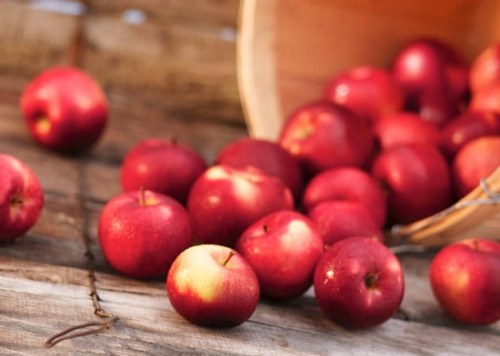
We have all heard about marathon runners chowing-down on pasta heavy meals the night before a 26-mile race in what is commonly called "carbo-loading". It is an effort to supply the body with energy efficient carbohydrates that will be a ready fuel source come race time the next morning. But for the average person engaging in modest physical activity for weight loss or weight control, such carbo-loading is detrimental to our efforts. In fact, there are very few occasions where one will require the energy to perform physically that warrants a carbo-loading meal.
Weight Loss Surgery (WLS) patients who are following their bariatric guidelines know they must exercise daily in order to lose weight and maintain that weight loss. As they lose weight their endurance and intensity of physical activity will naturally increase. Often traditional physical activity enthusiasts will encourage WLS patients to eat high energy carbohydrate-dense snack bars before exercise. These may negate the caloric benefits of exercise for the patient and lead to discouragement when weight loss stalls or weight gain occurs.
For many WLS patients a better solution is to eat a nutrient dense apple about 30 minutes before exercise. Apples are low-glycemic* which means eating one instead of a high-glycemic energy bar will reduce the amount of insulin needed to digest it. That makes it easier for the body to burn fat and when the low-glycemic snack is followed by exercise the body will continue to burn body fat for the next few hours. Our goal in weight loss is to lose body fat, not muscle, so the combination of a low-glycemic snack with exercise is beneficial in reaching this goal.
Apples are available year round and they are affordable. They are exceptionally high in antioxidants, which can help offset the damage caused by free radicals, an unfortunate by-product of daily exercise. They are also rich in vitamin C as well as potassium. A medium apple provides about 81 calories and nearly 4 grams of fiber. Some of the fiber in apples is pectin, which may help lower blood cholesterol. Before exercise try slicing a tart apple and spreading the slices with peanut or almond butter (2 teaspoons). This will add a perfect balance of protein and fat to your healthy low-glycemic pre-exercise snack.
At the market look for apples that are hard and unbruised. Most of our better supermarkets now offer less-common apples alongside the familiar varieties of Golden Delicious and Red Delicious. Try Empire, Fuji, Jonagold or Crispin apples. But do not forget the old favorites including the tart and juicy Granny Smith.
* Low-Glycemic foods have less effect on your blood glucose than foods with a high glycemic index. High-GI foods tend to cause spikes in your glucose levels, whereas low-GI foods tend to cause gentle increases. Different carbohydrate foods can behave quite differently in the body. Some break down quickly during digestion and release glucose rapidly into the bloodstream; others break down gradually and slowly trickle glucose into the blood stream.Kaye Bailey (c) 2010 - All Rights Reserved
|
LivingAfterWLS:
Serving the WLS Community Since 2006
Don't trust your weight loss surgery life to anyplace else.
Spam-Free ~ Privacy Protected
Nurturing Empowerment
Thank you for being a loyal Neighbor of LivingAfterWLS. We are proud to serve you in your weight loss surgery journey.
Sincerely,
Kaye Bailey
LivingAfterWLS, LLC
The health content in the LivingAfterWLS website is intended to inform, not prescribe, and is not meant to be a substitute for the advice and care of a qualified health-care professional.
LivingAfterWLS, LLC
Kaye Bailey, Founder
Evanston, Wyoming 82931
|
|
|
|
|
Redefined: No More
Good Carbs/Bad Carbs
| | |
Simple Carbohydrates:
Foods that contain a lot of sugar --syrups, jelly, honey, soda, molasses and have few, if any, vitamins and minerals and no fiber.
Complex Carbohydrates:
Foods that contain a lot of starch --vegetables, fruits, beans, whole grains, and pasta. They are rich in vitamins, minerals, and fiber.
|
Four Rules Refresher Course
Our Most Requested Newsletters
|
Four Rules Infographic
| 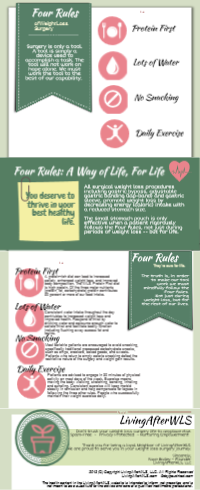 | Click image to view full size.
|
Cooking with Kaye:
Methods to Meals
| |
134 Irresistible Recipes - Tips & Hints - Nutritional Wisdom
Introducing Kaye's "Pace of Preparation"
|
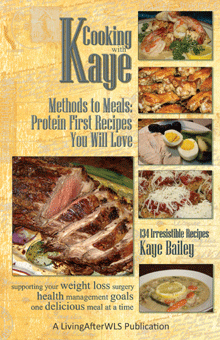 | | Buy Now |
Kaye Bailey's all-new highly anticipated cookbook is a hit in the WLS community. Written for the weight loss surgery patient and the people they cook for, this hard-back comb bound cookbook features 134 all new recipes and detailed techniques to take you beyond the meal to create recipes you and your family will love. Must have for any WLS household. Introducing Kaye's new "Pace of Preparation" to identify recipes that meet your time schedule and serve your dietary needs. Meals for the blended household (WLS & non-WLS eaters), couples, singles, all of us. Recipe categories include soups, salads, crunchy protein, savory skillet meals, oven baking and roasting, braising and slow cooking. Enjoy something delicious today: get Cooking with Kaye. Cooking with Kaye is suitable for all bariatric procedures including gastric bypass, adjustable gastric banding, gastric sleeve and others. Learn More
|

5 Day Pouch Test July Bulletin
Secret to successful WLS
Special Edition Digest
Must Read:
Obesity Reclassified.
"Obesity is a medical condition, not a moral failure."
5 Day Pouch Test June Bulletin
Don't Blame the Equipment
Cooking with Kaye
July 25, 2013
Refreshing Beverages
Cooking with Kaye
June 18, 2013
The Tricky Salad Plate
Weekly Digest July 23, 2013
Diet Soda is Making us Sick
Weekly Digest: June 10, 2103
Summer Living After WLS:
The Heat is ON!
Weekly Digest: June 1, 2013
Summer LivingAfterWLS:
Make this Your Best Year Ever
|
| If Broccoli Is So Good for Me, Why Does It Make Me Sick After Weight Loss Surgery? |
| |
People in pursuit of healthy weight management know to stick close to the veggie tray at parties and buffets. After all, vegetables are good healthy food full of beneficial vitamins, nutrients and fiber. But some vegetables, particularly cruciferous vegetables like the ubiquitous broccoli and cauliflower, can cause severe gastric upset when eaten raw by patients of gastric weight loss surgery. In fact, there are many examples of weight loss surgery patients who have experienced gastric distress so severe after eating raw broccoli or cauliflower that a trip to the emergency room was needed.
The reason weight loss surgery patients of all procedures (gastric bypass, gastric sleeve, adjustable gastric banding or lap-band) are prone to discomfort after eating raw cruciferous vegetables is a matter of balance. The vegetables are rich in enzymes which are believed to aid digestion. However, due to the shortened gastric tract and loss of stomach acid the vegetables cannot be fully digested in their short trip through the intestinal tract. The problem is compounded by the presence of cellulose, the dietary fiber in the vegetables that requires intestinal bacteria to process. Even without gastric weight loss surgery many humans lack enough intestinal bacteria to break down the cellulose enough to avoid symptoms of gas, bloating, and cramping.
After weight loss surgery many patients are intently focused on becoming healthy and in control of their weight through proper diet and nutrition and increased daily activity. These are admirable pursuits which often lead to the conundrum over eating good healthy vegetables at the risk of severe gastric distress. Frustrated patients wonder, If it is so good for me why does it make me feel so bad? Good question. There are a few measures that may be taken to reduce the discomfort that follows eating raw vegetables so we can have our nutrients and enjoy them too. Take a look:
Experiment cautiously
If you do not know how you will respond to raw vegetables go easy at first and avoid discomfort or embarrassment that may come from eating too much of a good thing. In addition, remember that from day to day foods will sit differently. Always practice restraint while you get a feel for how food is setting with you that day.
Lightly steam or parboil vegetables
to begin breaking-down the cellular structure thus helping the intestinal acid get busy more quickly with digestion. Remember, if you cannot digest the vegetable you will not be able to absorb the vitamins and nutrients in the vegetable. To serve the steamed or parboiled vegetables chilled simply prepare them in advance, drain of water and pat dry. Plate, cover and chill. Then serve cold with a lightly seasoned veggie dip made from yogurt which contains healthy bacteria that will aid in digestion. Avoid dairy-based dips, such as those made with sour cream, as this may increase the chance of stomach discomfort.
Take a digestive enzyme
as directed prior to or shortly after eating raw vegetables. There are many digestive enzyme supplements available at reasonable cost. Many weight loss surgery patients report that papaya enzyme is effective in reducing digestive discomfort. According to one maker of papaya enzyme the dietary supplement contains "papain, a proteolytic enzyme and a popular ingredient in dietary supplements used for digestion. Taken after meals, it is a perfect natural supplement that may assist in digestion and may help reduce the effects of poor digestion, including heartburn and gas." As with all dietary supplements keep in mind the FDA does not evaluate these claims or approve supplements for their claimed use. Consumers should consult with a health care professional before using any dietary supplement.
Chew, chew, chew. Remember that digestion begins in the mouth and it is critical to chew completely all raw vegetables in order to give your gastric system the best conditions under which to digest food and benefit from the vitamins and nutrients it contains.
Kaye Bailey (c) - All Rights Reserved
|
|
|